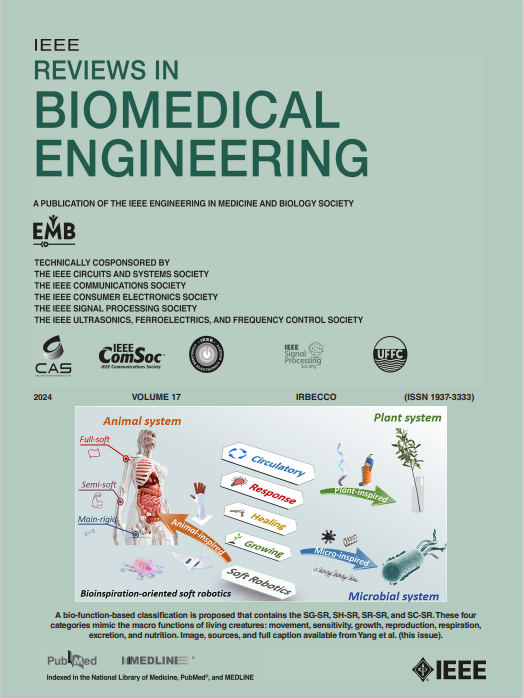使用软致动器和传感器进行人体压缩的综述:应用、机制和挑战》一书中的一篇评论。
IF 12
1区 工程技术
Q1 ENGINEERING, BIOMEDICAL
引用次数: 5
摘要
通过服装或充气气动装置对人体进行压缩,在美学、运动、机器人、触觉、宇航,特别是医疗领域有多种应用,用于治疗各种疾病,如静脉曲张、淋巴水肿、深静脉血栓和正压性不耐受。传统上,压力治疗是通过尺寸不足(如弹性)或尺寸可调(如充气)的压力衣来实现的。这些系统的设计目的是对身体施加基本均匀的压力。然而,由于解剖结构的变化和身体姿势的改变等原因,可能会对身体施加不同程度的压力。此外,据报道,由于穿戴困难,患者会感到高度不适,并且不服从治疗。因此,人们一直在努力通过采用先进的功能性软材料和致动器(如形状记忆合金(SMA)、形状记忆聚合物(SMP)、电活性聚合物(EAP)等)以及软力-压力传感器来实现压力衣的智能化,从而可以根据每个人或特定任务来控制和调节压力水平。然而,尽管取得了这些进步,但要精确控制人体压缩水平仍面临挑战,这主要是由于软致动器或传感器的固有特性以及复杂的人体条件造成的。在本文中,我们将首先研究有可能用于人体压缩应用的软致动器和传感器。然后,研究用于界面压缩的集成软传感-执行系统。最后,我们将介绍这项工作可能面临的挑战。本文章由计算机程序翻译,如有差异,请以英文原文为准。
A Review in On-Body Compression Using Soft Actuators and Sensors: Applications, Mechanisms, and Challenges
Body compression through a garment or inflatable pneumatic mechanism has various applications in aesthetic, athletic, robotics, haptics, astronautics, and especially medical fields for treatment of various disorders such as varicose veins, lymphedema, deep vein thrombosis, and orthostatic intolerance. Traditionally, compression has been done through under-sized (e.g. elastic) or size-adjustable (e.g. inflatable) compression garments. Such systems are designed to apply substantially uniform pressure on the body. However, due to reasons such as anatomical variations and body posture change, different levels of compression may be applied to the body. Further, a high level of discomfort and non-compliance is reported among patients due to donning difficulties. Therefore, there have been some efforts to make compression garments smart by employing advanced functional soft materials and actuators (such as Shape Memory Alloy (SMA), Shape Memory Polymer (SMP), Electroactive polymer (EAP), etc.) as well as soft force-pressure sensors so that the compression level could be controlled and regulated for each person or specific tasks. However, despite these advances, there are still challenges to accurately controlling the on-body compression level that are mainly due to the inherent characteristics of the soft actuators or sensors and the sophisticated human body conditions. In this paper, we will first investigate the soft actuators and sensors that have the potential to be used for on-body compression applications. Then, integrated soft sensing-actuation systems for interfacial compression purposes are studied. Finally, the challenges that might be associated with this work are introduced.
求助全文
通过发布文献求助,成功后即可免费获取论文全文。
去求助
来源期刊

IEEE Reviews in Biomedical Engineering
Engineering-Biomedical Engineering
CiteScore
31.70
自引率
0.60%
发文量
93
期刊介绍:
IEEE Reviews in Biomedical Engineering (RBME) serves as a platform to review the state-of-the-art and trends in the interdisciplinary field of biomedical engineering, which encompasses engineering, life sciences, and medicine. The journal aims to consolidate research and reviews for members of all IEEE societies interested in biomedical engineering. Recognizing the demand for comprehensive reviews among authors of various IEEE journals, RBME addresses this need by receiving, reviewing, and publishing scholarly works under one umbrella. It covers a broad spectrum, from historical to modern developments in biomedical engineering and the integration of technologies from various IEEE societies into the life sciences and medicine.
 求助内容:
求助内容: 应助结果提醒方式:
应助结果提醒方式:


